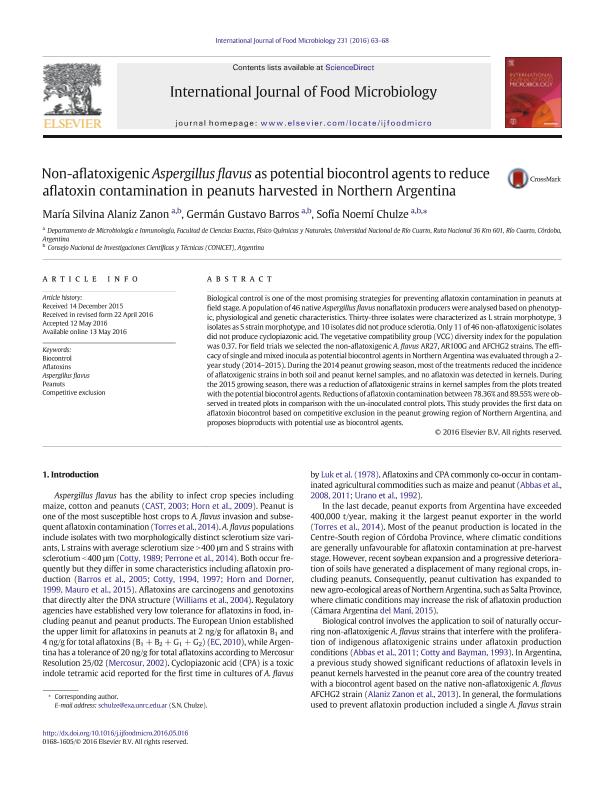Mostrar el registro sencillo del ítem
dc.contributor.author
Alaniz Zanon, Maria Silvina

dc.contributor.author
Barros, Germán Gustavo

dc.contributor.author
Chulze, Sofia Noemi

dc.date.available
2019-03-22T17:50:41Z
dc.date.issued
2016-08
dc.identifier.citation
Alaniz Zanon, Maria Silvina; Barros, Germán Gustavo; Chulze, Sofia Noemi; Non-aflatoxigenic Aspergillus flavus as potential biocontrol agents to reduce aflatoxin contamination in peanuts harvested in Northern Argentina; Elsevier Science; International Journal of Food Microbiology; 231; 8-2016; 63-68
dc.identifier.issn
0168-1605
dc.identifier.uri
http://hdl.handle.net/11336/72314
dc.description.abstract
Biological control is one of the most promising strategies for preventing aflatoxin contamination in peanuts at field stage. A population of 46 native Aspergillus flavus nonaflatoxin producers were analysed based on phenotypic, physiological and genetic characteristics. Thirty-three isolates were characterized as L strain morphotype, 3 isolates as S strain morphotype, and 10 isolates did not produce sclerotia. Only 11 of 46 non-aflatoxigenic isolates did not produce cyclopiazonic acid. The vegetative compatibility group (VCG) diversity index for the population was 0.37. For field trials we selected the non-aflatoxigenic A. flavus AR27, AR100G and AFCHG2 strains. The efficacy of single and mixed inocula as potential biocontrol agents in Northern Argentina was evaluated through a 2-year study (2014-2015). During the 2014 peanut growing season, most of the treatments reduced the incidence of aflatoxigenic strains in both soil and peanut kernel samples, and no aflatoxin was detected in kernels. During the 2015 growing season, there was a reduction of aflatoxigenic strains in kernel samples from the plots treated with the potential biocontrol agents. Reductions of aflatoxin contamination between 78.36% and 89.55% were observed in treated plots in comparison with the un-inoculated control plots. This study provides the first data on aflatoxin biocontrol based on competitive exclusion in the peanut growing region of Northern Argentina, and proposes bioproducts with potential use as biocontrol agents.
dc.format
application/pdf
dc.language.iso
eng
dc.publisher
Elsevier Science

dc.rights
info:eu-repo/semantics/openAccess
dc.rights.uri
https://creativecommons.org/licenses/by-nc-nd/2.5/ar/
dc.subject
Aflatoxins
dc.subject
Aspergillus Flavus
dc.subject
Biocontrol
dc.subject
Competitive Exclusion
dc.subject
Peanuts
dc.subject.classification
Otras Ciencias Biológicas

dc.subject.classification
Ciencias Biológicas

dc.subject.classification
CIENCIAS NATURALES Y EXACTAS

dc.title
Non-aflatoxigenic Aspergillus flavus as potential biocontrol agents to reduce aflatoxin contamination in peanuts harvested in Northern Argentina
dc.type
info:eu-repo/semantics/article
dc.type
info:ar-repo/semantics/artículo
dc.type
info:eu-repo/semantics/publishedVersion
dc.date.updated
2019-03-21T14:11:08Z
dc.journal.volume
231
dc.journal.pagination
63-68
dc.journal.pais
Países Bajos

dc.journal.ciudad
Amsterdam
dc.description.fil
Fil: Alaniz Zanon, Maria Silvina. Universidad Nacional de Río Cuarto. Facultad de Ciencias Exactas, Fisicoquímicas y Naturales. Departamento de Microbiología e Inmunología; Argentina. Consejo Nacional de Investigaciones Científicas y Técnicas; Argentina
dc.description.fil
Fil: Barros, Germán Gustavo. Universidad Nacional de Río Cuarto. Facultad de Ciencias Exactas, Fisicoquímicas y Naturales. Departamento de Microbiología e Inmunología; Argentina. Consejo Nacional de Investigaciones Científicas y Técnicas; Argentina
dc.description.fil
Fil: Chulze, Sofia Noemi. Universidad Nacional de Río Cuarto. Facultad de Ciencias Exactas, Fisicoquímicas y Naturales. Departamento de Microbiología e Inmunología; Argentina. Consejo Nacional de Investigaciones Científicas y Técnicas; Argentina
dc.journal.title
International Journal of Food Microbiology

dc.relation.alternativeid
info:eu-repo/semantics/altIdentifier/doi/http://dx.doi.org/10.1016/j.ijfoodmicro.2016.05.016
dc.relation.alternativeid
info:eu-repo/semantics/altIdentifier/url/https://www.sciencedirect.com/science/article/pii/S0168160516302264
Archivos asociados
